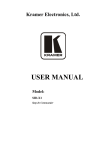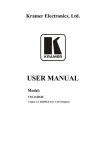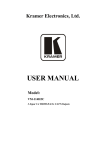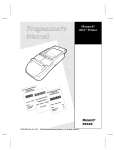Download USER MANUAL - Conference Room AV
Transcript
K R A ME R E LE CT R O N IC S L TD . USER MANUAL MODEL: SID-X1N Step-in Commander P/N: 2900-300302 Rev 2 Contents 1 Introduction 1 2 2.1 2.2 2.3 2.4 Getting Started Achieving the Best Performance Safety Instructions Shielded Twisted Pair/Unshielded Twisted Pair Recycling Kramer Products 2 2 2 3 3 3 Overview 4 4 Defining the SID-X1N Step-in Commander 5 5 5.1 5.2 5.3 6 6.1 6.2 Connecting the SID-X1N Connecting the Remote Step-In Switch and LED Connecting the Remote Select Switch and LED Connecting the Remote Input Selection LEDs Principles of Operation Video Input Selection Audio Signal Control 7 8 9 10 11 11 12 7 7.1 7.2 7.3 Operating the SID-X1N Manually Selecting an Input Taking Control of the Switcher Input Locking the EDID 13 13 13 14 8 8.1 9 Configuring and Maintaining the SID-X1N Setting the Configuration DIP-switch Wiring the Twisted Pair RJ-45 Connectors 15 15 16 10 Technical Specifications 17 Figures Figure 1: SID-X1N Step-in Commander Front Panel Figure 2: SID-X1N Step-in Commander Rear Panel Figure 3: Connecting the SID-X1N Step-in Commander Figure 4: Remote Step-In Switch and LED Wiring Figure 5: Remote Select Switch and LED Wiring Figure 6: Remote Input Indicator LED Connections Figure 7: Example of a Remote Input Indicator LED Wiring for the DVI Input Figure 8: The Configuration DIP-switch Figure 9: TP Pinout Wiring 5 6 7 8 9 10 10 15 16 SID-X1N – Contents i 1 Introduction Welcome to Kramer Electronics! Since 1981, Kramer Electronics has been providing a world of unique, creative, and affordable solutions to the vast range of problems that confront video, audio, presentation, and broadcasting professionals on a daily basis. In recent years, we have redesigned and upgraded most of our line, making the best even better! Our 1,000-plus different models now appear in 11 groups that are clearly defined by function: GROUP 1: Distribution Amplifiers; GROUP 2: Switchers and Routers; GROUP 3: Control Systems; GROUP 4: Format/Standards Converters; GROUP 5: Range Extenders and Repeaters; GROUP 6: Specialty AV Products; GROUP 7: Scan Converters and Scalers; GROUP 8: Cables and Connectors; GROUP 9: Room Connectivity; GROUP 10: Accessories and Rack Adapters and GROUP 11: Sierra Video Products. Thank you for purchasing the Kramer MegaTOOLS® SID-X1N Step-in Commander which is ideal for: Display systems requiring simple input selection Remote monitoring of computer activity in schools and businesses Rental/staging applications Multimedia and presentation source selection SID-X1N - Introduction 1 2 Getting Started We recommend that you: Unpack the equipment carefully and save the original box and packaging materials for possible future shipment Review the contents of this user manual i 2.1 Go to http://www.kramerelectronics.com/support/product_downloads.asp to check for up-to-date user manuals, application programs, and to check if firmware upgrades are available (where appropriate). Achieving the Best Performance To achieve the best performance: Use only good quality connection cables (we recommend Kramer highresolution, high-quality cables) to avoid interference, deterioration in signal quality due to poor matching, and elevated noise levels (often associated with low quality cables) Do not secure the cables in tight bundles or roll the slack into tight coils Avoid interference from neighboring electrical appliances that may adversely influence signal quality Position your Kramer SID-X1N away from moisture, excessive sunlight and dust ! 2.2 Safety Instructions ! 2 This equipment is to be used only inside a building. It may only be connected to other equipment that is installed inside a building. Caution: There are no operator serviceable parts inside the unit Warning: Use only the Kramer Electronics input power wall adapter that is provided with the unit Warning: Disconnect the power and unplug the unit from the wall before installing SID-X1N - Getting Started 2.3 Shielded Twisted Pair/Unshielded Twisted Pair Kramer engineers have developed special twisted pair cables to best match our digital twisted pair products; the Kramer BC-DGKat623 (CAT 6 23 AWG cable), and the Kramer BC-DGKat7a23 (CAT 7a 23 AWG cable). These specially built cables significantly outperform regular CAT 6 and CAT 7a cables. 2.4 Recycling Kramer Products The Waste Electrical and Electronic Equipment (WEEE) Directive 2002/96/EC aims to reduce the amount of WEEE sent for disposal to landfill or incineration by requiring it to be collected and recycled. To comply with the WEEE Directive, Kramer Electronics has made arrangements with the European Advanced Recycling Network (EARN) and will cover any costs of treatment, recycling and recovery of waste Kramer Electronics branded equipment on arrival at the EARN facility. For details of Kramer’s recycling arrangements in your particular country go to our recycling pages at http://www.kramerelectronics.com/support/recycling/. SID-X1N - Getting Started 3 3 Overview The SID-X1N accepts an HDMI, DisplayPort, DVI and PC graphics video input, as well as an unbalanced stereo audio input (which is embedded into the output signal), and transmits the signal via TP (Twisted Pair) cable to a compatible switcher or DGKat receiver, (for example, the VP-81SIDN or PT-572+). The device also provides an unbalanced, stereo audio output. When the SID-X1N is connected to a switcher, it also controls the input and output selection of the switcher. In particular the SID-X1N: features: HDTV support HDMI with x.v.Color™ and 3D HDCP compliancy—works with sources that support HDCP repeater mode Input signal detection based on video clock presence Automatic input selection based on manual selection or last connected input Automatic analog audio detection and embedding Installation up to 50m (164ft) from the switcher, (30m with the TP-574) I-EDIDPro™ Kramer Intelligent EDID Processing™ – Intelligent EDID handling & processing algorithm ensures Plug and Play operation for HDMI systems A lockable EDID Equalization and reclocking of the data A maximum data rate of 4.95Gbps (1.65Gb per graphics channel) Support for digital audio formats A MegaTOOLS® sized enclosure. Two devices can be mounted in a rack using the optional RK-T2B adapter You can control the SID-X1N using the front panel buttons, or remotely via contact closure switches. 4 SID-X1N - Overview 4 Defining the SID-X1N Step-in Commander Figure 1 defines the front panel of the SID-X1N. Figure 1: SID-X1N Step-in Commander Front Panel # Feature Function 1 AUDIO IN 3.5mm Mini Jack Connect to an unbalanced stereo audio source 2 3 4 HDMI LED Lights green when the HDMI input is selected HDMI Connector Connect to an HDMI source LED Lights green when the DisplayPort input is selected DP Connector Connect to a DisplayPort source LED Lights green when the DVI input is selected DVI Connector Connect to a DVI source 8 LED Lights green when the PC-UXGA input is selected 9 PC-UXGA PC-UXGA 15-pin HD Connector (F) Connect to a PC graphics source 10 INPUT SELECT Button Press repeatedly to cycle through the inputs manually to select an input, (overrides automatic selection, see Section 7.1). Note: When the button is lit it is inactive and pressing the button will not activate the input 11 STEP-IN Button Press to activate the input on the switcher that the SID-X1N is connected to, (see Section 7.2) 12 ON LED Lights green when the device is powered on 5 6 7 DisplayPort DVI SID-X1N - Defining the SID-X1N Step-in Commander 5 Figure 2 defines the rear panel of the SID-X1N. Figure 2: SID-X1N Step-in Commander Rear Panel # Feature Function 1 AUDIO OUT 3.5mm Mini Jack Connect to an unbalanced, stereo audio acceptor, (see Section 4) 2 TP OUT RJ-45 Connector Connect to a compatible switcher or DGKat receiver, (for example, VP-81SIDN or PT-572+) using CAT 6 or higher specification cable 3 REMOTE STEP-IN LED 3-pin Terminal Switch Block Connect to the anode of the remote Step-In LED indicator PROG RS-232 3-pin Terminal Block Connect to the PC via RS-232 to perform a firmware upgrade 4 5 6 Connect to the remote, Step-In switch, (see Section 5.1) LED Connect to the anode of the remote Input Select LED indicator, (see Section 4) Switch Connect to the remote, Input Select switch, (see Section 5.2) LED HDMI, DP, DVI and UXGA Connect to the anodes of the remote input indicators (see Section 5.3) 8 REMOTE SELECT 8-pin Terminal Block 9 OPTION 8-way DIP-switch Used to set the device behavior, (see Section 8.1) 10 12V DC Power Connector Connect to supplied power adapter, center pin positive 7 6 SID-X1N - Defining the SID-X1N Step-in Commander 5 Connecting the SID-X1N i Switch off the power to all devices before connecting them to your SID-X1N. After connecting your SID-X1N connect the power to other devices. Figure 3: Connecting the SID-X1N Step-in Commander To connect the SID-X1N as illustrated in Figure 3: 1. Connect up to four video sources, (for example, Blu-ray disc player, laptop, two computer graphics sources) to the video input connectors. SID-X1N - Connecting the SID-X1N 7 2. Connect the unbalanced stereo audio source, (for example, the audio output from the laptop) to the AUDIO IN 3.5mm mini jack. 3. Connect the AUDIO OUT 3.5mm mini jack to the unbalanced, stereo audio acceptor, (for example, a power amplifier with speakers). 4. Connect the TP OUT RJ-45 connector to a compatible switcher, (for example, VP-81SIDN). 5. Connect the REMOTE STEP-IN 3-way terminal block to a contact-closure switch and LED (see Section 5.1). 6. Connect the REMOTE SELECT 3-way terminal block to a momentary contact-closure switch and LEDs (see Section 5.2). 7. Connect the LED ANODES 5-way terminal block to the remote input indicator LEDs (see Section 5.3). 8. Connect the power adapter to the SID-X1N and to the mains power. Note: All LED supplies include a current limiting resistor and are designed to work with any standard LED. 5.1 Connecting the Remote Step-In Switch and LED You can connect a remote, contact closure step-in switch to take control of the input of the attached switcher, as well as a remote step-in LED to the REMOTE STEP-IN terminal block on the rear panel of the SID-X1N. Figure 4 illustrates the connections from the terminal block to the switch and LED. Figure 4: Remote Step-In Switch and LED Wiring 8 SID-X1N - Connecting the SID-X1N To connect a remote step-in switch and LED as illustrated in the example in Figure 4: 1. Connect pins 2 and 3 from the terminal block to the remote step-in switch. 2. Connect pin 1 from the terminal block to the anode of the remote step-in LED. 3. Connect pin 3 from the terminal block to the cathode of the remote step-in LED. 5.2 Connecting the Remote Select Switch and LED You can connect a remote, contact closure, input selection switch to activate an input (momentary contact is sufficient to switch inputs), as well as an indicator LED to the terminal block on the rear panel of the SID-X1N. Figure 5 illustrates the connections from the terminal block to the switch and LED. Figure 5: Remote Select Switch and LED Wiring To connect a remote selection switch and LED as illustrated in the example in Figure 5: 1. Connect pins 2 and 3 from the terminal block to the remote selection switch. 2. Connect pin 1 from the terminal block to the anode of the remote selection LED. 3. Connect pin 3 from the terminal block to the cathode of the remote selection LED. SID-X1N - Connecting the SID-X1N 9 5.3 Connecting the Remote Input Selection LEDs You can connect remote, input selection LEDS to the LED terminal block on the rear panel of the SID-X1N to indicate which is the active input. Figure 6 illustrates the connections from the terminal block to the LEDs. Figure 6: Remote Input Indicator LED Connections To connect remote input indicator LEDs: 1. Connect pin 1 from the terminal block to the anode of the remote HDMI indicator LED. 2. Connect pin 2 from the terminal block to the anode of the remote DP indicator LED. 3. Connect pin 3 from the terminal block to the anode of the remote DVI indicator LED (see the example in Figure 7). 4. Connect pin 4 from the terminal block to the anode of the remote UXGA indicator LED. 5. Connect pin 5 from the terminal block to the cathode of each LED. Figure 7: Example of a Remote Input Indicator LED Wiring for the DVI Input 10 SID-X1N - Connecting the SID-X1N 6 Principles of Operation This chapter describes the principles of operation of the SID-X1N and comprises: Video input selection (see Section 6.1) Audio signal control (see Section 6.2) The SID-X1N selects video and audio inputs based on the rules described below. 6.1 Video Input Selection The video mode selection is set by the DIP-switches (see Section 8.1) to either of the following: Manual Last connected In manual mode the input is selected using the front panel buttons and occurs whether or not there is a live signal present on the input. In last connected mode the SID-X1N selects the input based on which input was connected last. If the signal on this input is subsequently lost for any reason, the input with a live signal with the highest priority is selected automatically. The priority from highest to lowest is: HDMI DisplayPort DVI PC Note: In last connected mode, manually selecting an input using the front panel Input Select button overrides the last-connected automatic selection. When the input signal sync is lost (but the cable is not removed) there is a delay of six seconds before another input is automatically selected. When an input cable is removed, the delay before automatic switching takes place is configurable, (see Section 8.1). SID-X1N - Principles of Operation 11 6.2 Audio Signal Control The Option DIP-switches 2 and 3 (see Section 8.1) control the manner in which audio is handled. The following table describes which audio signal is embedded in the output. DIP-switch 2 12 DIP-switch 3 3.5mm Mini Jack Input Audio on Output On/Off On/Off On/Off VGA Off On/Off Inserted HDMI/DP/DVI 3.5mm mini jack 3.5mm mini jack Not inserted Embedded HDMI/DP/DVI On On/Off Inserted/Not inserted HDMI/DP Embedded HDMI/DP On Off Inserted/Not inserted DVI Embedded DVI On On Inserted/Not inserted 3.5mm mini jack SID-X1N - Principles of Operation 7 Operating the SID-X1N This chapter describes the operating procedures of the SID-X1N and comprises: Manually selecting an input (see Section 7.1) Taking control of the switcher input (see Section 7.2) Locking the EDID (see Section 7.3) Powering up the SID-X1N recalls from the non-volatile memory the last settings that were in force when the device was powered down. The SID-X1N inputs can be selected remotely via the VP-81SIDN. For details on how to do so, see the VP-81SIDN User Manual. 7.1 Manually Selecting an Input Note: When the button is lit it is inactive and pressing the button will not activate the input. To manually select an input: Press the INPUT SELECT button repeatedly until the required input is active as indicated by the associated LED. Note: The manual selection overrides any input selection when in last connected mode and remains in effect until the device is power cycled. 7.2 Taking Control of the Switcher Input To activate the input of the switcher to which the SID-X1N is connected, press the STEP-IN button. If the switcher grants the SID-X1N access to the input, the STEPIN button lights. If the switcher does not grant access for some reason, the button flashes for a few seconds and then does not light. One reason for this may be that the switcher input connected to the SID-X1N has been set to have a lower priority than the currently active input. Note: Input priority on the switcher is set using the Kramer Control Software. SID-X1N - Operating the SID-X1N 13 7.3 Locking the EDID The currently stored EDID can be locked to prevent it from being overwritten. To lock the current EDID, set DIP-switch 5 to ON (see Section 8.1). Note: The device must be power-cycled after you change this DIP-switch. 14 SID-X1N - Operating the SID-X1N 8 Configuring and Maintaining the SID-X1N 8.1 Setting the Configuration DIP-switch The 8-way dip-switch provides the ability to configure a number of device functions. A switch that is down is on, a switch that is up is off. By default, all switches are up (off). Figure 8: The Configuration DIP-switch # Feature Function DIP-switch 1 Program Enables firmware updates On—Enable updating Off—Disable updating 2 General audio control Selects whether the analog audio is embedded in the outputs, (see Section 6.2) On—Use embedded audio and DIP-switch 3 controls DVI audio Off—Use analog audio 3 DVI audio control (active only when DIP-switch 2 is on) Selects whether the analog audio is embedded in the DVI signal On—Use analog audio in DVI signal Off—Use whatever audio is present on the DVI input 4 Video mode input selection Sets the video input selection mode to either last connected or manual, (see Section 6.1) On—Last connected Off—Manual 5 Lock EDID Locks the current EDID, (see Section 7.3) On—Locked EDID Off—Automatic EDID selection 6 Switching delay Selects the time delay before switching occurs when a input cable is removed On—0.5seconds Off—5 seconds Note: When the input sync is lost but the cable is not removed, the delay is always six seconds 7 8 For future use Note: DIP-switch 2 must be set to ON to enable DIP-switch 3 to control the DVI audio mode selection. SID-X1N - Configuring and Maintaining the SID-X1N 15 9 Wiring the Twisted Pair RJ-45 Connectors When using STP cable, connect/solder the cable shield to the RJ-45 connector shield. Figure 9 defines the TP pinout using a straight pin-to-pin cable with RJ-45 connectors. EIA /TIA 568B PIN 1 Wire Color Orange / White 2 Orange 3 Green / White 4 Blue 5 Blue / White 6 Green 7 Brown / White 8 Brown Pair 1 4 and 5 Pair 2 1 and 2 Pair 3 3 and 6 ! 16 Warning: Figure 9: TP Pinout Wiring Using a TP cable that is incorrectly wired will cause permanent damage to the device SID-X1N - Wiring the Twisted Pair RJ-45 Connectors 10 Technical Specifications INPUTS: OUTPUTS: PORTS: CONTROLS: STANDARDS: MAXIMUM DATA RATE: MAXIMUM STEP-IN DISTANCE: POWER CONSUMPTION: OPERATING TEMPERATURE: STORAGE TEMPERATURE: HUMIDITY: DIMENSIONS: Video: 1 HDMI on an HDMI connector 1 DP on a DisplayPort connector 1 DVI-D on a DVI-I connector 1 VGA on a 15-pin HD (F) connector Audio: 1 Unbalanced stereo audio on a 3.5mm mini jack 1 TP on an RJ-45 1 Unbalanced stereo audio in a 3.5mm mini jack 1 RS-232 3-pin terminal block for programming Front panel buttons, remote step-in switch, remote input selection switches HDMI with x.v.Color™ and 3D HDCP: Works with sources that support HDCP repeater mode 4.95Gbps (1.65Gb per graphics channel) 50m (164ft) up to 1080p @60Hz @24bpp 12V DC, 950mA 0° to +40°C (32° to 104°F) –40° to +70°C (–40° to 158°F) 10% to 90%, RHL non-condensing 18.8cm x 11.3cm x 2.5cm (7.4” x 4.5” x 1”) W, D, H rackmountable WEIGHT: 0.48kg (1.1lbs) approx. INCLUDED ACCESSORIES: OPTIONS: Power adapter 19“ Rack adapter RK-T2B, RTBUS-12, RTBUS-22, SID-X1BP Kit (substitute black top plate for the SID-X1N to blend in with the color of the modular TBUS-10xl) SID-X1N - Technical Specifications 17 For the latest information on our products and a list of Kramer distributors, visit our Web site where updates to this user manual may be found. We welcome your questions, comments, and feedback. Web site: www.kramerelectronics.com E-mail: [email protected] ! SAFETY WARNING Disconnect the unit from the power supply before opening and servicing P/N: 2900- 300302 Rev: 2











































